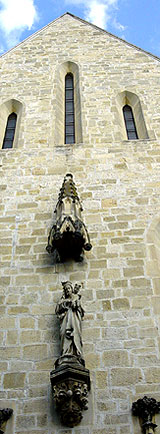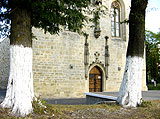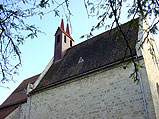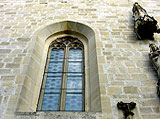
   |
The southern wall of the Calvaria Church has a built-in
sundial that dates back from the XVth century, considered to be one of
the oldest in Transylvania.
The site also hosts a chapel, built in 1831, and a belfry, designed in 1922 by the renowned Hungarian architect Karoly Koos.
The “St. Mary” Calvaria Church dates from the beginning of the XIth century, when it was built by a Hungarian king on the remains of a fortification belonging to a former local ruler. The Church was a small part of a Benedictine Abbey, destroyed by the Tatars, in 1241, the monastery being restored 22 years later by king Bela the IVth, in Gothic style. A flourishing period began for the Abbey. Its walls were reinforced; new buildings were added to replace the ones destroyed. The Benedictine Abbey gained in economic and military importance. Moreover, it was allowed to guard and copy the most important papers of the time.
In 1366, on the occasion of an uprising of the Cluj craftsmen, the monastery was severely destroyed. More destruction was to follow in 1437, because of the peasants uprising at Bobalna.
The site also hosts a chapel, built in 1831, and a belfry, designed in 1922 by the renowned Hungarian architect Karoly Koos.
The “St. Mary” Calvaria Church dates from the beginning of the XIth century, when it was built by a Hungarian king on the remains of a fortification belonging to a former local ruler. The Church was a small part of a Benedictine Abbey, destroyed by the Tatars, in 1241, the monastery being restored 22 years later by king Bela the IVth, in Gothic style. A flourishing period began for the Abbey. Its walls were reinforced; new buildings were added to replace the ones destroyed. The Benedictine Abbey gained in economic and military importance. Moreover, it was allowed to guard and copy the most important papers of the time.
In 1366, on the occasion of an uprising of the Cluj craftsmen, the monastery was severely destroyed. More destruction was to follow in 1437, because of the peasants uprising at Bobalna.
 |
 |
||||||
|
|
|||||||
 |
 |

The church was given the final look between 1470-1508.
In the beginning, the choir loft was built and the building was painted
and adorned with stained glass. The church entered the Jesuits’ temporary
possession in 1581, at the same time with other six villages. Shortly
after, the church was destroyed by lightning and then restored again.
After the Jesuits left, the church was used only at holy days and for
personalities’ funerals. Another Tatar invasion (1658-1661) caused
more destruction. As if this had not completed the destructive process,
beginning with 1773, the building was used as an arsenal storehouse. All
that was left was the choir loft, rarely used in important holy days.
However, the Greek-roman clergy rebuilt the nave in 1896 and offered the
church to the Franciscans in 1922, who turned down the offer.
The Greek Catholic Church administered the church for 25 years, until in entered the Orthodox ownership, in 1948, the time when all the other religious cults in Romania were forbidden. The Greek Catholics were rendered back the church in 1994 and they restored it between 1995-1997.
The Greek Catholic Church administered the church for 25 years, until in entered the Orthodox ownership, in 1948, the time when all the other religious cults in Romania were forbidden. The Greek Catholics were rendered back the church in 1994 and they restored it between 1995-1997.
 |
 |
|||
 |
||||
|
www.CLUJonline.com © 2005-2014
All Rights Reserved
|






